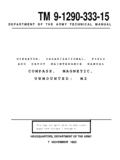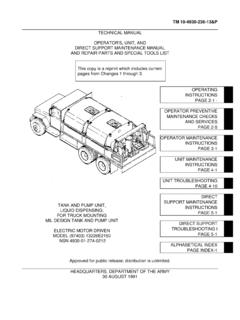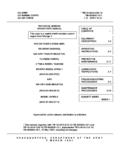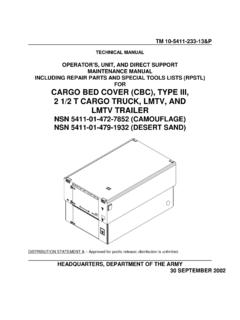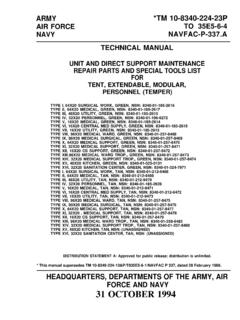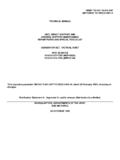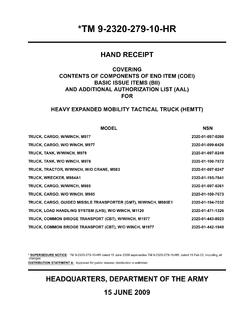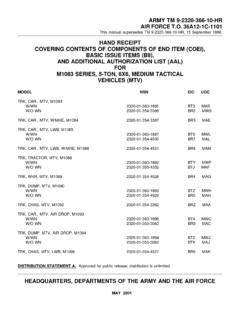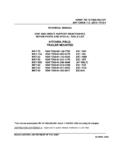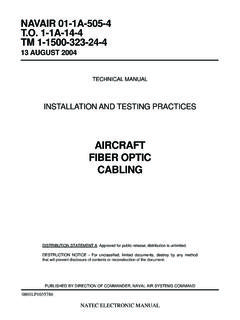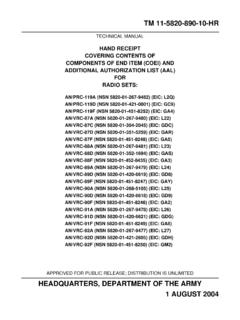Transcription of TRUCK, UTILITY: S250 SHELTER CARRIER, 4X4, M1113 …
1 ARMY TM 9-2320-387-10 AIR FORCE TO 36A12-1A-3061-1 MARINE CORPS TM 11033-OROPERATOR S MANUALFORTRUCK, utility : S250 SHELTER carrier , 4X4, M1113 (2320-01-412-0143) (EIC: B6B); truck , utility : UP-ARMOREDCARRIER, 4X4, M1114(2320-01-413-3739) (EIC: B6C); truck , utility : EXPANDED CAPACITY, ARMAMENT carrier , M1151(2320-01-518-7330) (EIC: BA5); truck , utility : EXPANDED CAPACITY, ARMAMENT CARRIER, IAP/ARMOR READY, M1151A1(2320-01-540-2038) (EIC: BEG); truck , utility : EXPANDED CAPACITY, ENHANCED, M1152(2320-01-518-7332) (EIC: BA6); truck , utility : EXPANDEDCAPACITY, ENHANCED,IAP/ARMOR READY, M1152A1(2320-01-540-2007) (EIC: BEH); truck , utility : COMMAND AND CON-TROL/GENERAL PURPOSE VEHICLE, M1165(2320-01-540-1993) (EIC: BEK); truck , utility : COMMAND AND CON-TROL/GENERAL PURPOSE VEHICLE,IAP/ARMOR READY, M1165A1(2320-01-540-2017) (EIC: BEJ); truck , utility : EXPANDED CAPACITY,TOW ITAS carrier , M1167(2320-01-544-9638).
2 HEADQUARTERS, DEPARTMENTS OF THE ARMY,THE AIR FORCE, AND MARINE CORPSOCTOBER 1997 PCN 184 110330 00 HOW TO USE THIS MANUALiiiINTRODUCTION1-1 MAINTENANCE INSTRUCTIONS 3-1 OPERATING INSTRUCTIONS2-1 REFERENCESA-1 additional authorization C-1 LIST (AAL)ON-VEHICLE EQUIPMENTF-1 LOADING PLANSSTOWAGE AND SIGN GUIDEE-1 LUBRICATION INSTRUCTIONS G-1 INDEXINDEX 1 COMPONENTS OF END ITEM (COEI) AND BASIC ISSUE B-1 ITEMS (BII) LISTSEXPENDABLE/DURABLESUPPLIES ANDD-1 MATERIALS LISTDISTRIBUTION STATEMENT A: Approved for public release; distribution is GASES CAN KILLB rain damage or death can result from heavy exposure.
3 Precautions must befollowed to ensure crew safety when the personnel heater or engine of any vehicle isoperated for any Do not operate your vehicle engine in enclosed Do not idle vehicle engine with windows Be alert at all times for exhaust Be alert for exhaust poisoning symptoms. They are: Headache Dizziness Sleepiness Loss of muscular control5. If you see another person with exhaust poisoning symptoms: Remove person from area Expose to open air Keep person warm Do not permit physical exercise Administer artificial respiration, if necessary* Notify a medic*For artificial respiration, refer to FM BE AWARE, the field protective mask for Nuclear, Biological, or Chemical(NBC) protection will not protect you from carbon monoxide BEST DEFENSE AGAINST EXHAUST POISONING IS aTM 9-2320-387-10 WARNING SUMMARY Do not attempt to operate cargo shell door forward latch.
4 The cargo shell door isnot to be opened from inside the vehicle. Opening cargo shell door from inside thevehicle may cause damage to equipment or injury to personnel. Drycleaning solvent is flammable and will not be used near an open fire extinguisher will be kept nearby when the solvent is used. Use only in well-ventilated places. Failure to do this may result in injury to personnel and/or damage to equipment. Protective gloves, clothing, and/or respiratory equipment must be worn whenevercaustic, toxic, or flammable cleaning solutions are used.
5 Failure to do this mayresult in injury to personnel. Do not perform fuel or battery system checks, inspections, or maintenance whilesmoking or near sparks. Fuel may ignite and batteries may explode, causingdamage to vehicle and injury or death to personnel. Never use transmission shift lever in place of parking brake. Set parking transmission shift lever is in P (park) position and transfer case shiftlever is NOT in N (neutral) position. Damage to equipment and injury topersonnel may occur if these instructions are not followed.
6 Ensure all slack from the three-point seatbelt or Improved Personal RestraintSystem is removed. The three-point seatbelt and Improved Personal RestraintSystem will lock only during sudden stops or impact. Injury and/or death topersonnel may result if an accident occurs and seatbelts or lap and shoulderstraps are not in use or adjusted properly. This vehicle has been designed to operate safely and efficiently within the limitsspecified in this TM. Operations beyond these limits are prohibited IAW AR 750-1without written approval from the Commander, Army Tank-automotive andArmaments Command, ATTN: AMSTA-CM-S, Warren, MI 48397-5000.
7 Use extreme caution when transporting personnel. Although certain designcharacteristics of the vehicle, such as vehicle width, ground clearance,independent suspension, etc., provide improved capabilities, accidents can stillhappen. Operators are reminded to observe basic safe driving techniques/skills whenoperating the vehicle, especially when transporting personnel. Vehicle speed mustbe reduced consistent with weather and road/terrain conditions. Obstacles such asstumps and boulders must be avoided.
8 Failure to use basic safe drivingtechniques/skills may result in loss of control and an accident or rollover resultingin injury or death to personnel and damage to equipment. Since the troop/cargoarea has minimal overhead protections and does not have seatbelts, personnelseated here are at greater risk of serious injury. Prior to towing vehicle with rear wheels up, secure steering wheel to preventfront wheels from turning. Wear leather gloves when handling winch cable. Do not handle cable with barehands.
9 When fully extending winch cable, ensure that four wraps of winch cableremain on drum at all times. Direct all personnel to stand clear of winch cableduring winch operation. Failure to do this may cause damage to vehicle andinjury or death to personnel. Protective eye equipment (goggles/shield) must be worn when removing snapringsor springs. Failure to comply may result in injury to 9-2320-387-10warning bChange 5 WARNING SUMMARY (Cont d) Avoid using fire extinguisher in unventilated areas. Prolonged inhalation exposureto extinguishing agent or fumes from burning material may cause injury topersonnel.
10 Using fire extinguisher in windy area will cause rapid dispersal ofextinguishing agent and reduce effectiveness in fire control. Vehicle operation in snow is a hazardous condition. Operator must travel at reducedspeeds and be prepared to meet sudden changes in road conditions. Pump brakesgradually when stopping vehicle on ice or snow. Sudden braking will cause wheelsto lock and vehicle to slide out of control, causing damage to vehicle and injury ordeath to personnel. Do not rely on wet service brakes.
